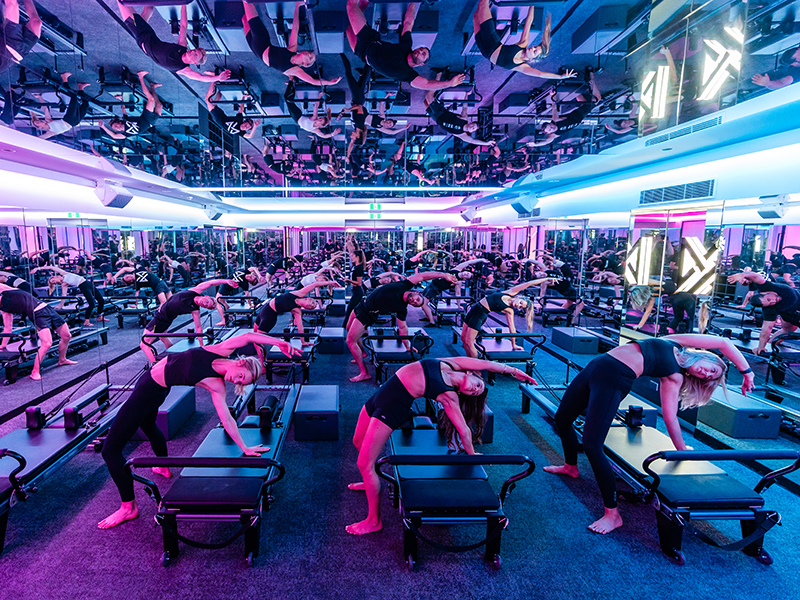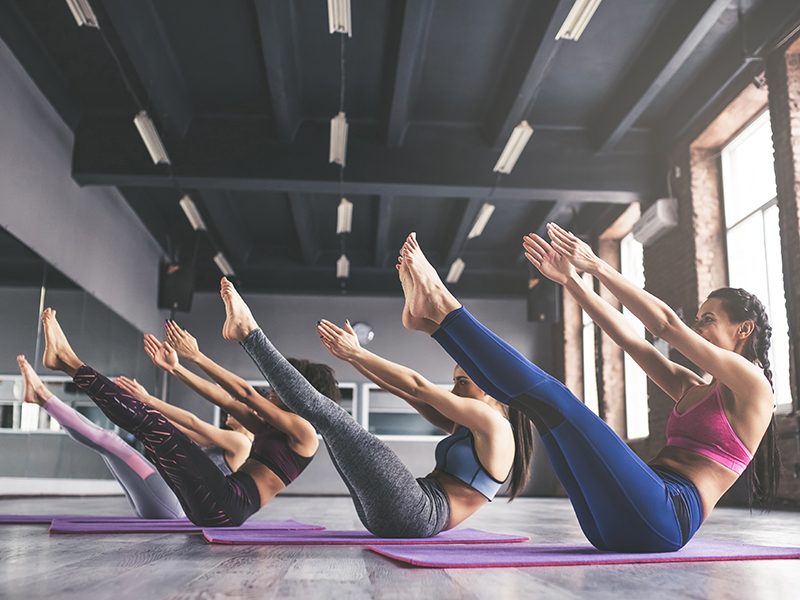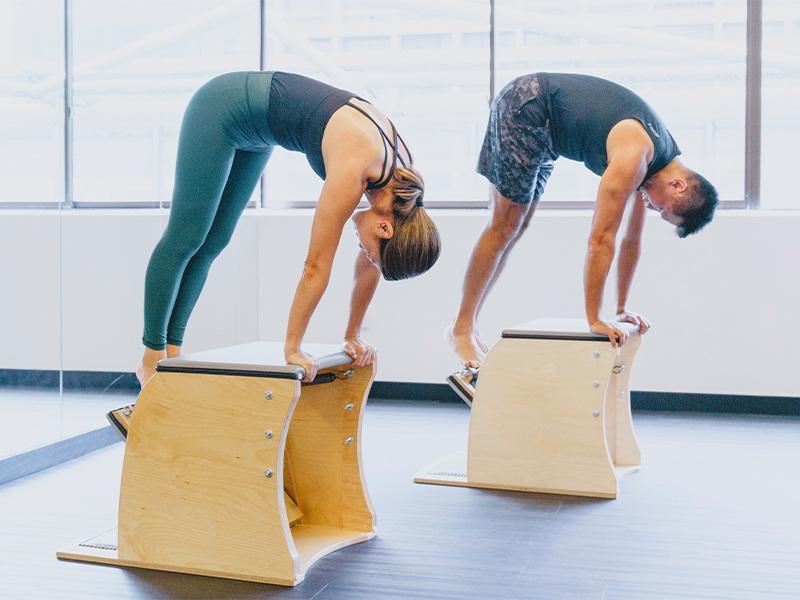Want to turn an ordinary workout into a transformative experience for body and mind? We asked Pilates instructors from top Singapore Pilates studios to share their views. Here, they discuss why they love these low-impact workouts and core exercises, including reformer and Classical Pilates – and the reasons you should give it a try. Roll out the mat and discover the many benefits of Pilates at these studios in Singapore!
The best Singapore Pilates studios
Flex Studio Singapore Classical Pilates
Authentic Classical Pilates devotees will be thrilled to know that Hong Kong’s premier Classical Pilates studio now has a state-of-the-art studio on Orchard Road in Singapore. With a dedicated focus on Joseph Pilates’ original system of movement (which follows a specific sequence of exercises to educate the body), you can expect a system of spring-based resistance training exercises designed to create long, lean muscles and build endurance without the risk of injury.
Offering dynamic small group classes, with just three members per class, the Pilates Trio group sessions are a fantastic way to use more Classical Pilates apparatus in a semi-private setting in Singapore. You’ll benefit from personal correction from the instructor, while working your abs on the Spine Corrector, challenging your strength, balance and stability on the Wunda Chair or Tower, and learning new exercises on the Classic Reformer.
Special offer for Expat Living readers: Get a Pilates Trio Trial at this Singapore Pilates studio for $58 (regular drop-in price is $99). Applicable to first-timers only.
A word from Flex Studio Pilates clients in Singapore
“I’m a Pilates newbie and the instructors provided great guidance on the steps and flow. The classes are small, hence the instructors can focus on each student. And the different pieces of equipment make the sessions interesting and varied.” – Michell Wee
“If you look at your body as an instrument, wouldn’t you want to have the best instruction to get the most benefit from your classes? As a former ballet dancer and Broadway performer, I can attest that going to Flex for Pilates in Singapore has refined my body and strength and I’m in great shape again.” –Gail Mae Ferguson
#05-02 Palais Renaissance, 390 Orchard Road
WhatsApp FLEX Concierge 9111 6855 | flexhk.com/singapore
Vive Active Reformer Pilates
Combining the sweet science of reformer Pilates in Singapore with the principles of strength training, this Tanglin studio has designed addictive results-driven workouts focused on total body conditioning. Whether you’re after increased strength, better flexibility or a sweaty HIIT session, there’s a transformative reformer Pilates class here to suit everyone – and no previous reformer experience is required!

Vive Total is a signature 50-minute class combining strength, endurance and stretch for a full-body burn. Take it a step further with Vive Fusion, a HIIT and strength training session that splits its time between reformer and floorwork. As the studio’s most challenging class, Vive Fusion uses heavier weights and tougher springs to sculpt your body. There’s also Vive Stretch, which draws from Pilates core exercises and yoga. It uses deep stretch poses to improve mobility, increase flexibility, and help with injury prevention.
If you’re looking for a slower-paced class, try Vive Nurture, which is especially designed for pre- and postnatal clients and those returning or new to exercise. The reformer Pilates instructors will help you progress through each stretch and movement with modifications and adjustments that allow you to achieve your fitness goals safely.
A word from a client
“I’ve been attending Vive Pilates studio in Singapore two to three times a week since the studio opened in 2022 and I absolutely love that it’s now part of my non-negotiable routine. My flexibility and core strength have improved immensely. I love the vibe and the instructors, and there are so many brilliant member perks too. Massive five gold stars from me.” – Alice O’Brien
Vive Active Joo Chiat: 381 Joo Chiat Road, Level 4
Vive Active Tanglin: #02/121-124 Tanglin Mall, 163 Tanglin Road
8044 8782 | viveactive.com.au
Benefits of Pilates
#1 Exercise for everyone
Pilates, which can be done with a just a mat or with the use of specialist equipment like the Pilates reformer, can be practised by anyone, regardless of age, gender or fitness abilities. That’s because Pilates instructors can adjust the exercises to suit each client’s specific needs and health conditions; in fact it’s a popular choice for prenatal and postnatal fitness, as it strengthens the pelvic floor, helping the body both to prepare for the delivery and to recover post-delivery.
#2 Stabilises the core at your local Pilates studio
The key to stability is the core (sometimes known as the “powerhouse”!), which includes the abdomen, lower back, obliques and pelvic floor. Having a stronger core means you can work out better as a whole, whether it be running, yoga, football, boot camp, you name it. Learning how to use muscles that provide stability while we move our extremities helps to safeguard against injury during daily chores or sports.

#3 Corrects posture and alignment – one of the many benefits of Pilates
Correct posture and alignment are also key to effective functioning throughout everyday activities, whether it be working out at the gym or sitting at a computer. A benefit of Pilates at a studio in Singapore is that it helps improve body awareness. In turn, this encourages proper alignment. This is important so that the muscles can work effectively without excessively straining any one muscle group
#4 Enhances your breathing
The improvement of your posture and the ability to stand or sit taller will encourage better, deeper breathing day to day. The focused breathing used to control the Pilates movements helps to optimise the deep abdominal contractions that are involved.
#5 Boosts the mind-body connection
Along with focused breathing, the concentration required to perform the exercises can help improve body awareness. This, in turn, can transfer to other areas of your training and your life. Quality in Pilates is far more important than the number of repetitions performed.
#6 Tones and strengthens
Pilates exercises involve all muscle groups, so you work on the entire body from head to toe. There’s a strong focus on deep abdominal contractions with each exercise, which improves core strength and tones the abdominals. Also, using your body weight, or equipment and props, helps to develop overall body strength and tones muscles.
#7 Enhances mobility and enhances flexibility
Posture deterioration, muscle tension, aches and pains are usually caused by tight muscles. The Pilates repertoire moves each joint in all possible angles. This improves flexibility and helps muscles reach their optimal length.
#8 Helps ease and prevent back pain
Having a stronger core means you’re less likely to develop a back injury. In fact, Pilates movements are often used as part of the rehabilitation – in addition to prevention – of lower back and neck injuries and pain. Just one of the many benefits of practicing Pilates at a studio in Singapore!
#9 Optimises balance and muscle control
Movements from Pilates studio instructors help create symmetry in the strength of opposing and unilateral muscles. Working one side of the body independently from the other side, and with the same resistance, achieves balance in the internal force production of left and right side muscles.
#10 Increases bone density
Pilates studio instructors will guide you through using both bodyweight and resistance from apparatuses. They’ll also use props to provide a good stress to the skeletal system. Pilates exercises delay this degenerative process, making our bones more resilient and less likely to fracture as we grow older.
A quick history of Pilates
As a sick child in late 19th-century Germany, Joseph Pilates – the son of a gymnast father and naturopath mother – dedicated himself to becoming stronger by studying anatomy and various forms of exercise. He got himself into top physical shape, posing for anatomical charts and becoming an accomplished circus performer, gymnast, skier and boxer in England.
Pilates was forced into an internment camp during World War I. That’s when he began developing his concept of Contrology – essentially what is now Pilates mat work. The focus was on core postural muscles and awareness of breath. As a caretaker for injured interns, he also invented rehabilitation equipment made from springs and hospital beds. This system became the foundation for his body-conditioning method using specialised apparatuses.
Around 1925, Pilates and his wife brought his technique to New York City. There, he opened his first studio catering primarily to performers and professional ballet dancers. The exercise system gained a devoted following, and is now taught by Pilates instructors around the globe in different variations.
Liked this article on the benefits of Pilates and Singapore Pilates studios offering Classical and reformer Pilates? Visit our Health & Fitness section for more ideas and inspiration.
To make the most of living in Singapore, read our latest City Guide here for free!






